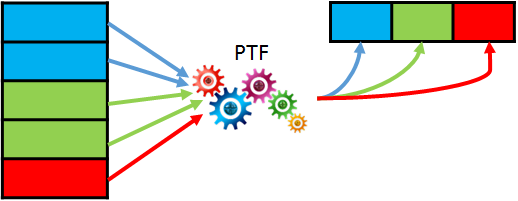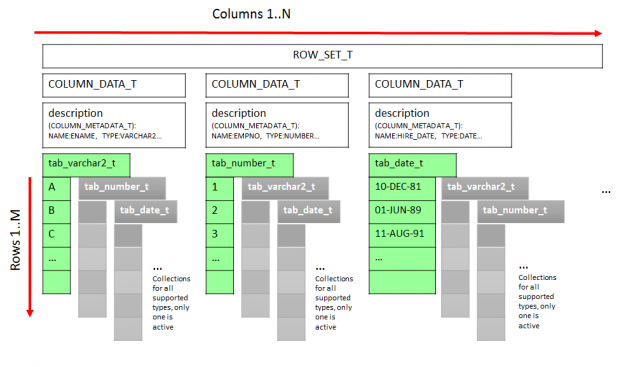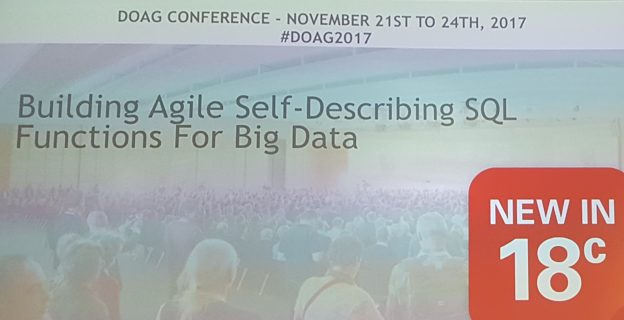Performing an ETL with large data sets, it is often a good idea to run DML in parallel. But, in contrast to parallel query or DDL, parallel DML has to be explicitly enabled. You had to issue ALTER SESSION ENABLE PARALLEL DML in the past. Starting with 12c you can enable parallel DML specifically for each query using the hint ENABLE_PARALLEL_DML. For a few years now, I’ve been using the hint now and then and was quite happy. An observation I made a few days ago can lead to a rethinking. What I could observe is that for the SQL with embedded hint a new child cursor was created each time. Let’s test it!
Continue readingCategory Archives: General

Dynamic Pivot with Polymorphic Table Function?
LiveSQL is great place to start playing with new features. It provides a couple of very helpful demo scripts explaining how polymorphic table functions work. There I found a new script few days ago which uses PTF for dynamic pivot! WOW! According to my subjective perception, it seems to be one of the most desired features in Oracle SQL! But let’s have a closer look. Is this really feasible and mature enough to be used in production code?
Continue reading
Polymorphic Table Functions (PTF) , Part 3 – Row Replication
In the third part of the PTF-series we learn how a PTF can change the cardinality of the input data flow: return more or less rows as in the input. We’ll use the same simple table as in the part 2 and our new task will be column transposing. We’ll still define, which columns have to stay unchanged (as we already did using the parameter cols2stay). All other columns should be displayed as key-value pairs. Continue reading

Polymorphic Table Functions (PTF) , Part 2 – More Basics With Some Deep-Dive
In the first part of PTF series we went through a very basic example removing some columns and adding a new column with a constant value. Starting from the same example we’ll do something more meaningful in the second part. How about concatenating the values of the removed columns as CSV in a new column? Continue reading

Polymorphic Table Functions (PTF) – Tinkering with Rowsets
Writing the second “basics” post on PTF I discovered, that there were much more details worth mentioning, than it would be acceptable for a “basics” post and would blow it up anyway 😉 So I decided to to separate the tests and finding in this (more deep-dive) post. Continue reading
Online Statistics Gathering for ETL – Part 1
Online Statistics Gathering has been introduced in 12c and is a very handy feature for ETL and batch jobs developers. However the devil is in the detail. There are some points to remember. Let’s take a closer look. Continue reading
Conditional Logic in SQL
A few days ago Sven Weller has published an excellent post about writing conditional logic in SQL and it reminded me of an example I used in one of my presentations. It is also about conditional logic in SQL but maybe some less obvious use cases in context of function calls and sorting. Continue reading
Polymorphic Table Functions Example – Transposing Columns To Rows
Hey, Oracle 18c is now available on the cloud and for engineered systems! For more than a week now. That also means you can play with it at LiveSQL. And of course you can try polymorphic table functions (PTF)! At least I’ve done that this weekend 😉 And here is my first working example. Continue reading

Polymorphic Table Functions
Last month I attended the DOAG conference in Nuremberg. As always, it was a great event, awesome community and excellent tech talks. And it seems that I’ve found what could be my favorite feature in the upcoming database release 18c. Keith Laker (@ASQLBarista), Oracle’s Product Manager for Analytic SQL, talked about “Building Agile Self-Describing SQL Functions For Big Data”. This title was promising enough for me and of course I wasn’t disappointed. Thanks a lot for an interesting presentation!
This blog post will be somewhat unusual, because I have actually no knowledge to share yet, but only the euphoria about the power and flexibility of the new feature. So what is it about?
Continue readingILM – is it possible to mix ADO policies for compression and storage?
Never thought I would write much about Information Lifecycle Management, as I am actually a developer and not a DBA. I think, it is indeed a topic mostly relevant for DBA’s. But it is generally a good thing, if developers and DBA’s have a deep understanding of each others job, isn’t it? We are giving an overview of the ILM features in our training “12c New Features for Developers” and I’m one of the course instructors for it. That’s the reason, why I’m writing meanwhile the third post about it. Just to clarify some questions, which are not so obviously documented.
After looking at ADO conditions for storage tiering policies and using user defined PL/SQL conditions in previous posts, I was curious whether it is possible to mix storage and compression policies for the same segment? Wouldn’t it for example make sense to move the segment to a low cost tablespace and compress the data within the same action as well? I’ve sometimes heard the opposite statement. But it is very simple to test it, not just trust it. Let’s try it. Continue reading
